how to tile a shower floor without a pan
How to Build Shower Pans
Learn the professional way to build custom shower pans
![]() Time
Time
Multiple Days
![]() Complexity
Complexity
Intermediate
![]() Cost
Cost
$101–250
Introduction
Learn how to build a custom-sized, waterproof shower pan for a curved shower enclosure by following these clear, detailed photos and step-by-step instructions.
Tools Required
Materials Required
- 1-1/4-in. roofing nails
- 1"x3/4"
- 10d galvanized nails
- 1x4
- 2x4
- 2x6
- 3-in. drywall screws
- Ceramic floor mix
- Duct tape
- Fiberglass mesh tape
- Galvanized expanded metal lath
- Hardboard siding
- Shower drain assembly
- String
- Thin-set mortar
- Tile backer board
- Vinyl membrane
These days, if you want to put in a shower, you can just go to a home center and pick up a fiberglass unit. Before that was possible, pros had to build a custom shower pan by mixing and applying mortar, troweling it flat, and laying ceramic shower floor tile.
Although fiberglass units make shower pans quick and easy, they lack the elegance of a handcrafted mortar and tile floor. So if you'd like to install a tile shower and are willing to build your own custom shower pan, you'll be able to tile it to match the walls. And with a mortar and tile floor, your shower can be any shape. (For instance, see How to Install a Glass Block Shower.) In fact, no matter what its shape, if the shower you have in mind doesn't conform to the rigid size requirements of a manufactured base, a mortar floor may be your only alternative.
You'll find that the cost of the materials used in a hand-crafted base is roughly the same as the cost of a comparably sized fiberglass pan. The downside is that instead of just plugging a manufactured unit into the opening, you'll have to do a lot more work. You'll need a couple of days to form and tamp in two layers of mortar, deal with some tricky vinyl membrane liner and then install the tile. Installing shower pans isn't a project for winging it or taking shortcuts. Poorly installed shower pans will leak, and the only correct way to fix a poor installation is to rip out not only the base but also the shower walls.
The shower pan installed in this project is somewhat complicated, but the fundamental techniques are the same for even the simplest shower — one the size of a phone booth. If you have experience with cement and some basic trowel skills, you should be able to do almost any size shower floor in less than two days, excluding tile work.
Anatomy of a Mortar Shower Floor
The first layer, called a sloped fill, is simply a mortar subfloor. It's sloped toward a special two-piece clamping-type drain (available at any home center) that is made specifically for a mortar bed shower floor. The sloped fill slants from the drain toward the perimeter of the shower with a slope of 1/4 inch per foot. Since our shower had an average width of 3 feet, we sloped up from the 1/4-inch thickness of the drain to a 1-inch thickness around the shower walls and curb to get the necessary 3/4-inch slope.
The second layer, called the pan, is a durable CPE (chlorinated polyethylene) membrane. This vinyl liner is turned up at the edges to create a waterproof membrane in the shape of a shallow pan. Water that works its way through the grout and the top layer of mortar will flow down the slope to be drained through the weep holes of the drain. On top of the pan is a layer of expanded galvanized metal lath to reinforce the mortar. Over the lath, a sloped mortar bed is laid using the same 1/4-inch-to-the-foot slope rule we used for the sloped fill.
Shower curbs help by containing water in areas that aren't bordered by walls. If a drain becomes blocked, perhaps by a washcloth over the surface, a curb buys you time. It will dam the water within the shower for a while before it lets it run over onto the bathroom floor.
(For a larger version of this drawing, see Additional Information, below.)
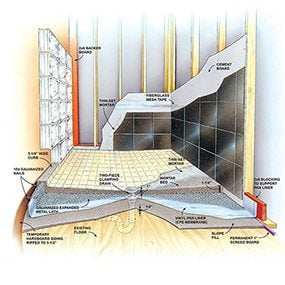
Project step-by-step (14)
Step 1
Draw the Floor
- Draw the outline of the shower floor on the subfloor to use as a pattern for setting the mortar forms.
- Nail an 8d nail next to the wall and strike a 65-inch arc for the curved form board.
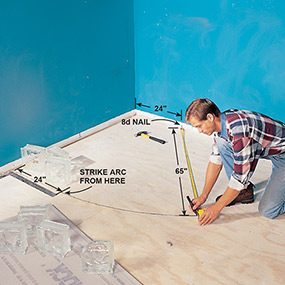
Step 2
Confirm the Layout
- Lay out the shower on the subfloor using your finish materials—in this case, tile and glass block—to help define its size and shape for shower pan installation.
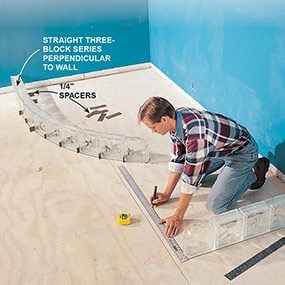
CAUTION!
The shower we designed and installed here weighs upward of 1,000 lbs., or about the same as a spa with a couple of people in it! If you live in an older home with 2x6 or 2x8 floor joists, you may need to beef up the floor with some beams or extra floor joists. If you're unsure, consult a building inspector. And if you have a house that was built in the '70s, it could have a 5/8-inch particleboard underlayment that will need to be removed before starting.
Sign Up For Our Newsletter
Complete DIY projects like a pro! Sign up for our newsletter!
Do It Right, Do It Yourself!
![]()
Step 3
Open the Walls
- Cut the drywall so that the seam of the drywall and cement board falls halfway behind the glass block.
- Install backers in the stud wall to support the cement board/drywall seam.
- Cut the top of the drywall at 6 feet, 2 inches above the plywood floor to allow for the slope fill and two layers of 3-feet wide cement board.

Step 4
Form the Curve
- Toe-nail 2x6 blocking at the base of the shower on interior walls to support the vinyl liner.
- Toe-screw 2x4 blocks to the subfloor every 12 inches and 1/2 inch away from the line to allow for the thickness of the hardboard siding.
- Rip the siding to 3-1/2 inches and screw it to the backside of the blocks for curved curbs.
- Toe-screw 2x4s for straight curbs and cut off the excess hardboard after forming.
- Pro tip: Toe screws are easier to remove after the mortar work is done.
- Nail in permanent 1-inch thick screed boards against walls.
- Rough-in the copper plumbing and drain water lines.
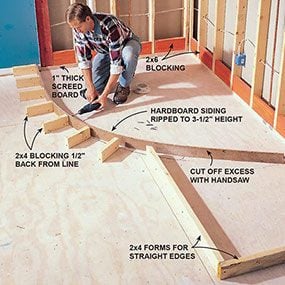
Planning Shower Layout
Keep these elements in mind when you're sizing and positioning your shower:
The tile layout. It's easier to determine the size of the shower if your wall tile is selected ahead of time. Since we had 12-inch tile, we made small alterations in the size until we had wall lengths that made full tiles come out just behind the inside edge of the glass block.
Shower doors. If your shower will have a door, pick it out in advance to make sure the shower opening will accommodate it. Don't forget to allow for the thickness of the tile and the cement board. When you're determining the size of the shower door and the direction it should swing, consider other bathroom doors and fixtures.
Plumbing. It's obviously much easier to hook up a new shower that is located near existing plumbing. Copper water lines, sewer drain lines and vents can be hooked up to pipes at a neighboring bathroom. Our shower backed up to a common wall that contained all the plumbing we needed. If you're installing your shower in a remote location, it can be tough to get to the sewer drain and still keep the shower drain within the required distance from the drain water vent. You may need to rip out walls or the ceiling below the shower to accomplish hook-ups if the next level down is finished. Sometimes plumbing a new bathroom is more work than building the shower from scratch.
Step 5
First Layer of Mortar
- Remove the top half of the shower drain and plug the drainpipe with a rag to prevent debris from falling into the plumbing.
- Pack the mortar with a wood float, then screed the first layer of mortar.
- Use removable 1-inch screed blocks along curbs to establish a 1-inch to 1/4-inch slope toward the drain.
- Work the surface smooth with a wood float and smooth with a steel trowel.
- Let the mortar harden overnight.
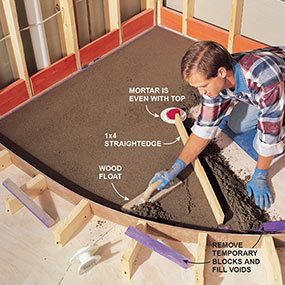
Step 6
Lay in the Liner
- Tack up scrap pieces of vinyl liner to protect the actual liner from the sharp edges of plumbing or electrical plates.
- Install the liner, running it up onto the walls at least 6 inches, and nail it to the studs with roofing nails at the top edge.
- Feel the drain flange bolts with your fingers and draw and carefully cut the liner to fit just outside the bolts.
- Cut off the liner against the curved edge 1/2 inch below the top of the form.

Step 7
Fold the Corners
- Chisel out the inside corners of the framing to create a recess for the liner folds.
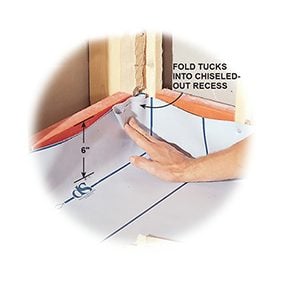
Step 8
Make a Drain Hole
- Cut out the vinyl liner for the drain with a utility knife, cutting just outside of the bolt holes.
- Run a bead of silicone caulk around the outer edge of the flange.
- Bolt down the top half of the drain assembly.
- Cover the top of the drain with duct tape to protect it during the installation of the mortar bed and tiling.
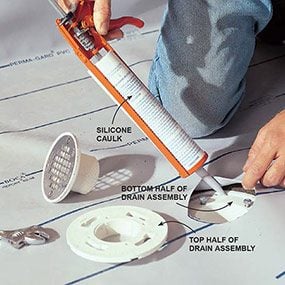
Step 9
Attach the Tile Backer Board
- Install cement board over the vinyl liner and screw it to the studs with coated cement board screws every 8 inches.
- Cut slots in the cement board to go over curbed areas against the walls.
- Tape the seams with fiberglass tape and thin-set mortar or mastic.
- Pro tip: When setting the cement board, face the smooth side out. This makes it much easier to spread the tile adhesive and get a flat surface for tiling and for drawing tile layout lines.
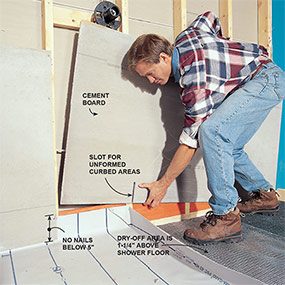
Step 10
Add the Metal Lath
- With a pair of tin snips, cut and lay in galvanized expanded metal lath on top of the liner just short of the cement board edges.
- Bend 12-inch x 3-foot lengths of lath over a 2x4 for curb reinforcement pieces.
- Keep the height barely under the form heights.
- Pro tip: For a curved curb, make a series of slits every 10 inches to help it bend to the shape of the hardboard form.
- Pro tip:Avoid walking on the lath. Its sharp edges can puncture your waterproof membrane.
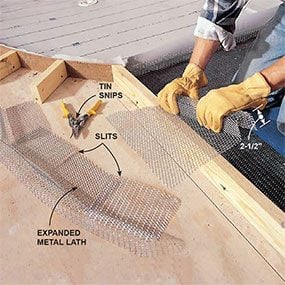
Step 11
Form the Curb
- Fold the vinyl liner and drop the pre-bent curb lath over the top of it.
- Poke a galvanized 10d nail through the lath and top edge of the liner to keep it from collapsing while you pack the curb with mortar.
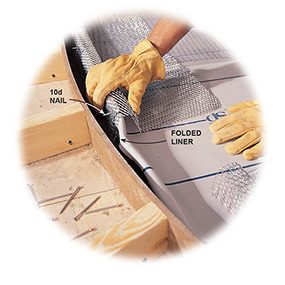
Step 12
Cover the Lath with Mortar
- Snap chalk lines against the cement board, making them 1-1/4 inch above the sloped fill.
- Adjust the top of the drain by screwing it up or down until it is 1 inch above the top of the slope fill.
- Pile mortar against the wall and compact it down to the line.
- Use the packed mortar as a guide for screeding off the mortar between the wall and the drain.
- Use the straightedge to locate high or low areas.
- Pack in mortar to fill depressions, and scrape off excess in the high spots.
- Use a steel trowel to smooth the bed and to tool sharp edges at all corners for a cleaner tiling job.
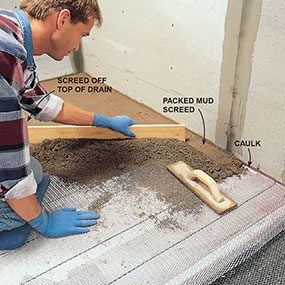
Step 13
Mortar the Curb
- Pack mortar into the lath with a wood float around the folded liner, then screed with a 3/4-inch plywood jig.
- After screeding, tool the edges of the curb with a trowel to obtain crisp edges.
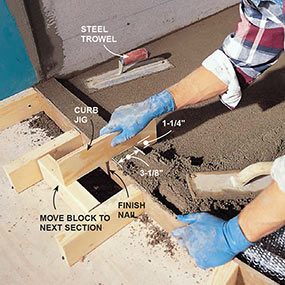
Step 14
Adjust the Drain
- Raise the shower drain by unscrewing it until it is the same height as the floor tile.
- Note: You have to do this before the mortar sets.

Additional Information
- Since this article was first published, new materials have become available for projects like this. See Pro Tile Tips for more information.
- Anatomy of a Mortar Shower Floor
how to tile a shower floor without a pan
Source: https://www.familyhandyman.com/project/how-to-build-shower-pans/
Posted by: hendersonsomakingdon.blogspot.com

0 Response to "how to tile a shower floor without a pan"
Post a Comment